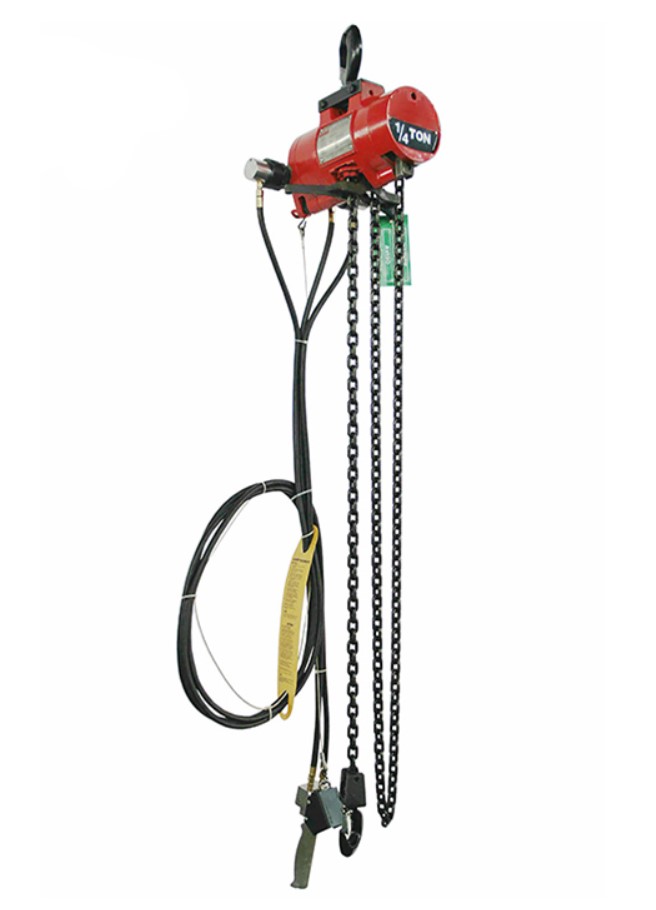What is an Air Hoist?
Air hoists, or pneumatic hoists, are ideal explosion-proof lifting equipment, mainly used in high-explosive dust environments such as petroleum, chemical, coal mines, textiles, and other situations where explosion-proof requirements are needed. As an upgraded alternative to electric hoists, air hoists operate efficiently with minimal energy consumption, requiring only compressed air at a specified pressure for operation. Air hoists are equipped with air-cut protection, which ensures that the workpiece does not descend or fall in case of sudden loss of air pressure. Additionally, these hoists can be paired with various non-standard lifting fixtures to accommodate workpieces of different shapes. They can also be used in conjunction with jib cranes or guide rails for mobility, making them essential tools for promoting safety and cost-effectiveness in industrial operations. ATO Automation Store offers air chain hoists with specifications ranging from 300 lb 10 ft to 2000 lb 20 ft, providing flexibility to meet diverse lifting needs.

Structure
- Hand Control Valve: Primarily composed of a handle, valve body, and buttons. Manipulating the buttons opens the valve to regulate the connection between the main control valve airway and the motor airway. Alternatively, the rotational movement of the lever through manual rope operation adjusts the valve opening, achieving continuously speed variation.
- Main Control Valve: Comprising left and right valve rods, connecting rods, and a distribution plate. Switching between the left and right airways completes the pneumatic motor’s forward and reverse rotation distribution.
- Pneumatic Motor: Featuring a rotor, stator, front and rear end covers, and blades. When the main control valve’s distribution plate delivers compressed air to the motor, the blades rotate rapidly alongside the rotor.
- Suspension: Consisting of a top hook, suspension body, sprocket, chain, bottom hook, and related parts. Ascending and descending motions are achieved through the sprocket’s forward and reverse rotation.
- Reducer: Mainly comprised of a housing and a set of planetary reduction mechanisms. When the pneumatic motor’s high-speed shaft enters the reduction mechanism, torque is increased through reduction and output to the lifting sprocket.
- Brake Mechanism: Comprising brake cones, brake rings, and cylinders. Air distributed from the main control valve to the cylinder separates the brake cones and rings, releasing the brake.
- Interlock Mechanism: Featuring a shaft, swing frame, and reset spring. It serves as a collision prevention and protection mechanism when reaching the up or down positions.
Working Principles
Taking the air chain hoist as an example, it comprises 3 main parts:
- Lifting Mechanism: This includes the pneumatic motor, planetary gearbox, suspension assembly, brake, lifting chain, hook assembly, and main control valve. Controlled by the main valve, this mechanism lifts and lowers heavy loads. The brake is used to ensure precise positioning during lifting and lowering. The pneumatic chain hoist guarantees safe lifting operations. The lifting mechanism can be either fixed in place or placed on a trolley for mobility.
- Travel Mechanism: This employs a pneumatic traveling trolley with active and passive wheels, along with a track. Controlled by the main valve, the pneumatic motor and planetary gearbox drive the active wheels, facilitating horizontal movement of the lifted load.
- Air Distribution System: Operating with compressed air as its power source, this system controls pneumatic circuits to execute the hoist’s lifting and traveling functions.
Advantages
- Precision Positioning: Avoids the common problem of imprecise positioning seen in typical lifting equipment, ensuring precise load placement down to the centimeter.
- Adjustable Speed: Provides smooth speed adjustment during lifting or lowering operations; it runs 3 times faster than electric hoists and 5-10 times faster than manual hoists.
- Simple Operation: Easily controlled with a lever, allowing for quick response to handle movements during lifting or lowering.
- Environmentally Friendly: Its internal lubrication system eliminates air pollution, making it suitable for operation in damp, humid, high-dust, or harsh environments.
- Effortless Handling: Air hoists are compact, lightweight, and easy to transport compared to electric alternatives. The robust product design ensures reliable operation with minimal maintenance.
- Overload Protection: Air hoists are equipped with automatic overload protection. When carrying a load, the pneumatic motor adjusts its speed or stops as needed. Once the load is removed, it can quickly return to normal operation without any common malfunctions.
- Air Cut-off Protection: Prevents sudden loss of air pressure, which could lead to the load dropping unexpectedly, providing further assurance of product quality and eliminating concerns about lifting or dropping incidents for end-users.
- Long-lasting Durability: Air hoists possess a significantly longer lifespan compared to similar products, thereby reducing end-user complaints about product quality issues.

